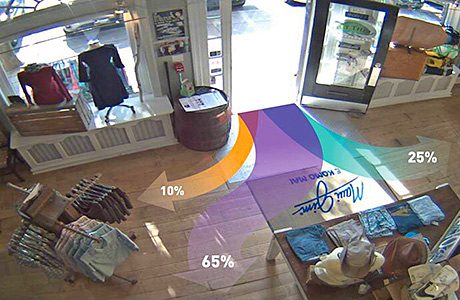
CCTV has a long track record in security and crime prevention. But by failing to use the cameras to gain valuable insights into the way a business is operating, says Footfall Analytics, retailers are missing a trick.
This company, based in London, uses a method developed in the US by Prism Skylabs to analyse a store’s existing CCTV footage and identify hot spots, dead spots and areas for improvement. The frequency of the changing images shows where shoppers dwell in store, what products they interact with and illustrate their path to purchase.
Footfall Analytics director, Gurshinder Liddar, compares the system to the methods used by e-tailers to analyse how customers behave online.
“A retailer needs to understand his or her customer behaviour,” he stressed. “When CCTV data captures everything that a customer does in store, the Prism Skylabs technology provides a powerful business intelligence tool for bricks and mortar retailers.
“Most current reporting will tell you footfall and sales conversion but it’s the gap in between that is missing.”
That, says Liddar, is where the CCTV analysis comes in “What is the consumer doing in store? What leads to sales conversion? That’s often not answered and we want to use the existing data that retailers have to find these answers.”
Sales transactions are broken down into three key areas: sales conversion, average transaction value and average number of items in a basket.
To unpick the behaviours underpinning the data, Footfall Analytics identifies dead areas and hot spots. “All stores have dead areas where there is relatively low footfall or draw,” explained Liddar.
“Consumers don’t stop to look and won’t buy. The challenge is to convert that dead area to a sales magnet. This may mean altering a layout, bringing in some individual merchandising space or encouraging brand partnerships to make this area more attractive.
“A store looking to rebrand or refit can monitor the effectiveness of change. A before and after report is set to measure the impact of those changes.”
Footfall Analytics worked with the Henderson Group, the company behind Northern Ireland’s 82 Spar franchises located in petrol forecourts across the country. The brief was to increase the number of items per transaction and convert the petrol-only consumers.
After analysis of the CCTV, Footfall Analaytics recommended changing the visual layout of the store to encourage consumers to explore more of floor area. Spend per transaction increased as consumers starting buying other items with their petrol.
Another convenience store retailer, south of the border in Gloucestershire, employed Footfall Analytics as part of a refit and branding exercise. Following the advice given by the company, post-refit sales increased by 19%.
Liddar said: “Consumer behaviours are always changing and retailers should be looking at business intelligence to measure change and encourage ongoing improvement in the customer experience.
“Retailers often have a perception of their store, which is based on experience and judgement, but the scientific results can show something different.
“The consumer needs to be central in retail operations and it’s about how we can educate retailers and use data to justify decision making. It’s about taking the data you already have and turning it into actionable insight.”


















